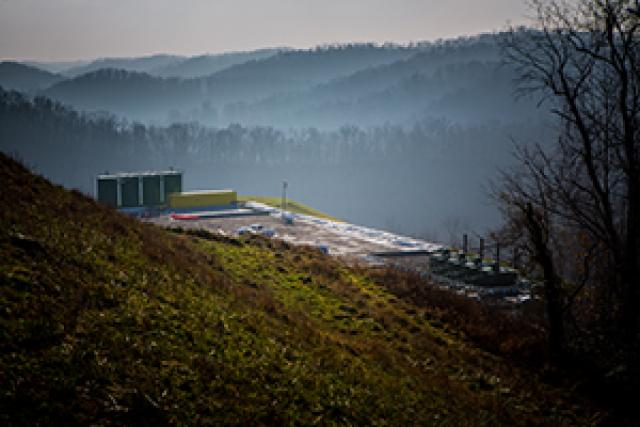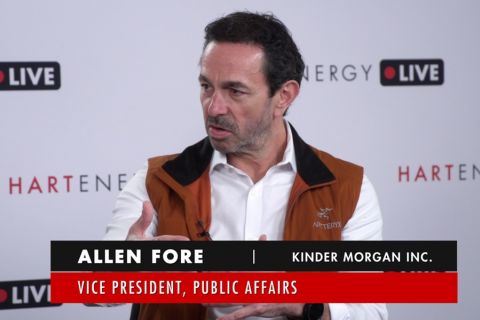
West Virginia Rising
With a long-time Pennsylvania track record, Marcellus Shale activity gains traction in West Virginia, where operators find economics comparable.
Article by Steve Toon
Photography by Mike Robinson
Paul Rady knows unconventional gas plays. In the late 1990s he, along with wingman Glen Warren, built Pennaco Energy, a Powder River Basin coalbed methane producer, into the highest-return public E&P of its day before selling in 2001. Next, they formed Antero Resources in the upstart Barnett Shale, forging the second-largest producer in the play in advance of its 2005 sale. Rady refocused in the Woodford Shale, again growing to No. 2 in total production. He ultimately sold the asset for nearly a half billion dollars in 2012.
So, when in 2008 they planted a stake in the West Virginia Marcellus Shale with 100,000 acres, while industry was focused in neighboring Pennsylvania to the north, their move seemed likely to set off a land rush, given their track record. Instead, Marcellus chasers were happy north of the Mason-Dixon Line, and Antero quietly constructed a 389,000-acre block in Doddridge, Tyler and Harrison counties to the south.
Today, as a pure-play Appalachian E&P, Antero is on pace to drill 100-plus horizontal Marcellus Shale wells a year in West Virginia, for average returns of 17% to 55%, depending on the liquids mix in the production stream and based on December 2014 strip pricing.


Paul Rady: CEO, Antero Resources
“We’ve been in West Virginia since the beginning,” Rady, chairman and CEO of Antero Resources Corp., which he took public in late 2013, said. “It’s interesting that a lot of Marcellus maps over the last four years stop at the bottom of Pennsylvania, but we knew what we were looking for in these developing shales when we started to scope the Marcellus. We saw that the geology didn’t change at the state line, and if anything, gets better in a number of aspects. It’s got a lot of good geologic and production attributes, including rich gas and liquids.”
Positive well results continue to flow out of Marcellus sweet spots in northeastern Pennsylvania, with abundant dry gas, and in southwestern Pennsylvania, where wet gas bumps up returns—particularly meaningful as negative basin differentials have trimmed realizations.
The entire Marcellus now produces 16 billion cubic feet of gas a day (Bcf/d), per the EIA, some 40% of all shale gas in the U.S.
But a trend is developing: 25 out of 100 total Marcellus rigs now operate in West Virginia, a solid quarter of all Marcellus activity. The word is out.
While Antero dominates the middle of the northwest West Virginia fairway, other operators like EQT Corp., Magnum Hunter Resources, Consol Energy and privately funded American Energy Partners (led by former Chesapeake Energy CEO Aubrey McClendon) have established sizeable footholds. At year-end, Southwestern Energy Co. entered with a bang, closing a $5 billion deal for West Virginia Marcellus assets culled from Chesapeake and Statoil.
Until recently, West Virginia was overlooked, Rady said. Now, “We’ve got plenty of neighbors.”
All rigs to the Mountain State
The Marcellus fairway arches through southwestern Pennsylvania and parallels the eastern side of the Ohio River down into West Virginia. Wet gas is prevalent to the west of the fairway, turning leaner going east as thermal maturity increases. The division roughly follows the county lines with Wetzel and Doddridge in the wet, and Monongalia, Marion and Harrison falling dry.
Glen Warren, Antero president and CFO, referenced a map in the company’s investor presentation, noting a black, oblong oval demarking a region north and east of Alleghany County in Pennsylvania, to just encompassing the northern regions of Ritchie, Gilmer and Lewis counties in West Virginia. Its label: Marcellus Shale Southwestern Core Area.
“Ninety percent of the Marcellus rigs running are within that oval,” he said. “There’s enough well control to say we feel quite good about everything in that oval. It could expand beyond that.”
When Antero acquired its initial Marcellus acreage from Dominion in 2008, natural gas prices were at an all-time high, from $8 to $12 per Mcf. “We didn’t have processing at first, and we were going for the dry gas initially,” Warren said. The company drilled 142 dry gas wells primarily in Harrison County with an average 30-day rate of 6 million cubic feet per day (MMcf/d) on an average 6,900-foot lateral.
But the world changed in 2009. Natural gas prices collapsed into a prolonged period hovering around $4 or below.
Today, Antero’s operations are concentrated in Doddridge County, where the gas stream is rich with higher-margin gas liquids, tethered to MarkWest’s Sherwood processing plant. Sherwood came online in 2012, opening the opportunity for rich gas development. Building the gathering and processing infrastructure took a bit of time, Warren said, but “we’re in good shape now. We have a lot of rigs running to the west now compared to a couple of years ago, and we can fairly well drill where we want.” The Sherwood facility can now process 1 billion cubic feet per day (Bcf/d), with another 400 million to be added this year. For 2015, he said, “you’ll see us continue to focus on the 1,200 to 1,300 Btu area in the western part of our acreage.”

Glen Warren: President and CFO, Antero Resources
Antero touts itself as the most active operator in Appalachia. It employs 15 rigs in West Virginia, five of which are tophole rigs, and plans to stay active through the year. To date, it has drilled and put online 340 total horizontal wells in its Marcellus program, with more than 3,100 identified drilling locations to go. Rigs today are focused in Doddridge, Tyler and Ritchie counties. Recent wells have 30-day initial production (IP) rates between 14 MMcfe/d on the low end, and 21 MMcfe/d on the high side.

A lack of faulting and a contiguous acreage position allow the company to drill longer laterals. Antero models a 7,000-foot average lateral in its economic analysis at $9.5 million, but in fact it averaged 8,600 feet over the past year, and up to 10,700 feet at times.
About a year back, Antero began using shorter-stage-length completions, about 200 feet in length. Estimated ultimate recoveries (EURs) on these new completions are about 1.7 Bcf per thousand feet of lateral, up from 1.5 Bcf. Well costs increased 10% to 15%.
Antero also holds 25,000 net acres in Washington County, Pennsylvania, with no rigs active there. “The wells are prolific, but it’s a little drier gas, and we don’t have as much critical mass there,” Rady said. “We can’t be everywhere, so it’s best for us to focus and build infrastructure in our West Virginia core where we’ve got 10 times as much acreage.”
“We have great economics,” Warren said, “with some of the lowest costs in North America from a well cost-per-Mcfe and capex-to-finding and development costs.”
Liquids production buffers the economics to a great extent, he said, “but you always have to pay attention to the commodity price movements, and this was certainly a dramatic one” over the past few months. “Oil came down so quickly and took NGLs with it. So we’re evaluating that now, and you’ll see us high grade and focus on the highest rate of return drilling projects in this environment.”
Hedging is a big part of Antero’s formula, with approximately 90% of its gas production hedged in 2015.
“We probably have the largest natural gas hedge book of any E&P,” said Rady. “We’re at about 1.85 Tcfe hedged over the next five years at good prices, and we’ll continue to hedge into the future for five or six years out in order to put a floor under a lot of our program.”

Antero produces about 1 Bcf/d currently, and it projects production growth of 45%-50% for 2015. With several thousand locations still to drill, Rady said he would continue to push the pace with an eye on commodity prices.
“If we drill 100 to 200 wells a year, depending on the year and as we escalate, we have at least a dozen years of development in West Virginia, and a similar amount in Ohio. The plan is to continue to drill and increase production and stay ahead on infrastructure.”

Antero Resources Pearl Jean water impoundment in Doddridge County, West Virginia.

Pennington compressor station in Doddridge County.

Doddridge County, West Virginia.

Pennington compressor station in Doddridge County.

Pennington compressor station.

Pennington compressor station.

Antero’s White Oak compressor station near Pullman, W.V., in Ritchie County.

White Oak compressor station.

White Oak compressor station.

White Oak compressor station.

A Frontier Drilling rig targeting the Marcellus Shale on Antero Resources’ Richards pad in Ritchie County, West Virginia.

Antero Resources’ Richards pad.

Antero Resources’ Richards pad.

Antero Resources’ Richards pad.

Antero Resources’ Richards pad.

Completion work on the Hayden Unit for Antero Resources on the Fritz pad in Doddridge County, W.V.

Antero Resources Fritz pad completion.

Antero Resources Fritz pad completion.

Antero Resources Fritz pad completion.

Antero Resources Fritz pad completion.

Antero Resources Fritz pad completion.

Oilfield traffic passes the Sunnyside Grill on Oxford Road near West Union, West Virginia.

Antero Silas Unit well on the Forest pad in Tyler County, W.V., waiting to be hydraulically stimulated.

Antero Forest pad.

Antero Forest pad.

Antero Forest pad.

Antero Forest pad.

Antero Forest pad.

Antero Forest pad.
Welcome to the show
If any doubts persist about the quality of West Virginia Marcellus rock, don’t tell Southwestern Energy Co. The Fayetteville Shale king paid more than $5.3 billion at year-end to stake its claim for 443,000 acres almost entirely in the Mountain State and establish a new core position. Southwestern also has significant operations in the northeast Pennsylvania Marcellus, making it the second-largest producer and third-largest acreage holder in Appalachia, according to the company.
“We are the only company to have significant positions in both core areas,” Southwestern CEO Steve Mueller said in a press release.
The new position covers a host of northwestern West Virginia counties, including a concentration in the panhandle, all the way down into Upshur and Randolph, and a dab in Pennsylvania’s Washington County. Acquired from Chesapeake Energy and Statoil, the new position comes with 1,500 wells—256 horizontal—producing 370 MMcfe/d. Proved reserves are 2.5 trillion cubic feet equivalent (Tcfe), with net potential of 45 Tcfe, a 20-year inventory.
Southwestern models EURs of 15.8 and 11.1 Bcfe for wet and dry Marcellus, respectively, 16.5 Bcfe for Utica, and 10.6 Bcfe for Upper Devonian, assuming a 7,500-foot lateral.

“We believe the acquired acreage is prospective for a minimum of three zones,” Mueller said. “Interestingly, the southwestern Appalachia purchases … provide Southwestern with a well inventory and ultimate resource potential that is similar to Antero’s total company position today,” he said in a conference call.
The Houston-based company is hitting the ground running, planning to drill about 70 wells in 2015: 12 in Brooke and Ohio counties; 24 in Marshall; 12 in Wetzel and Tyler; 24 in Monongalia; and six in Washington, Pennsylvania. It plans a ramp from one rig to four by year-end and has earmarked $625 million capex to the region.
“We believe this is a transformational asset for the company,” Mueller said.
Editor’s note: An in-depth interview with Southwestern president and COO Bill Way will run in the April issue of Oil and Gas Investor and online.
Straddling the line
To Gary Evans, the chairman and CEO of Magnum Hunter Resources, his company’s foothold in the Appalachian Basin straddling the Ohio River couldn’t be in a better position.

“This part of the country is unique in that you’ve got both Marcellus and Utica stacked on top of one another. These are two of the most prolific gas fields in the world.”
The Dallas-based company holds around 100,000 net Utica acres in Monroe, Noble and Washington counties, Ohio, and another 95,000 net Marcellus acres concentrated in Tyler, Ritchie, Pleasants and Wetzel counties, West Virginia, mirrored across the Ohio River. And it’s a toss-up as to which play is the better performer in today’s commodity cycle.
Magnum Hunter’s Marcellus and Utica operations sometimes overlap, literally drilled from the same pad site where the formations overlie across the Ohio-West Virginia border. As far as economics, Evans says the Marcellus and Utica are comparable, with the Marcellus holding a slight edge at this time. Utica wells are almost twice as expensive to drill and complete as compared to Marcellus wells, even on the same pad, because of depth and completion technique. But they are twice as prolific, competing on returns. At the same time, Evans believes that well costs in the Utica will continue to decline as they did in the Marcellus play, initiated in West Virginia by Magnum Hunter in 2010.

Liquids, of course, boost returns, and “everything we have drilled in the Marcellus is wet, and it gets wetter as we get closer to the Ohio River. We’re definitely seeing almost pure liquids-rich wells as we approach and cross the river.”
But, “now that liquids prices have dropped along with oil, which obviously affects the value of Marcellus liquids, that may change,” he said.
At the end of the year, Magnum Hunter turned on its four-well Stewart-Winland pad in Tyler County, West Virginia, featuring three Marcellus wells and one Utica well. The Marcellus wells all IPed near 17 MMcfe/d at peak rate and were on a restricted choke. They are also liquids rich, averaging 20% condensate and 25% NGLs. The wells were drilled with laterals of about 5,700 feet, and with 27 to 29 fracturing stages completed. Three more Marcellus wells are planned for the pad sometime in the future.
The Utica well, by the way, came on at 46.5 MMcf/d. On choke.
Newer Marcellus wells with enhanced completions show EURs approaching 12 Bcf and cost $6.5- to $7 million. This results in returns of 50% at $3 gas, and 70% at $4, per the company.
Magnum Hunter first entered West Virginia in 2010 with the strategic purchase of an undervalued company, and has built on that asset base. The company has now drilled more than 50 Marcellus wells. Wells drilled in 2014 more than triple the IPs and EURs of those drilled in 2010, Evans said, “so we’ve definitely gotten better.”
Having run four rigs in 2014, Magnum Hunter recently dropped its three contracted rigs and continues to drill forward with a single rig that it owns for both its Appalachia programs. That rig is currently on the Wells-Meckley pad drilling for the Marcellus in Tyler County.
Evans defers blaming the drop in oil price for the pullback, noting the production stream is primarily gas. Instead, the timing was right, he said. “We’ve got five pads we drilled last year being fracked and turned on now, so it’s just a timing situation. But all companies in the energy industry are being more conservative and tightening their belts, and we’re one of those as well.
“Of course, liquids did go down proportionally with oil, and gas has gone down too, from over $4.”
Magnum Hunter is planning approximately 10 new wells with its one rig throughout 2015, split between Marcellus and Utica targets, yet still anticipates 100% production growth in 2015 over 2014, a positive resulting from a combination of the overhang of shut-in wells from last year and new drills. “We’ve got five new highly productive pads coming on, so we don’t have to spend a whole lot of capital to have 100% production growth.”

The company plans to step out during 2015, testing its 20,000-acre block in Ritchie County to the south of current operations. Its midstream subsidiary, Eureka Hunter, has completed a pipeline to the field, so “you’ll see active drilling in Ritchie County.” Results from other offset operators and an operationally failed well from the previous operator on its land provide positive signs. “We’re excited about what we see down there.”
Magnum Hunter also has acreage in Pleasants County, bounded by Tyler and Ritchie counties and the Ohio River. How far south can it go and be economic? “We don’t really know yet. What we think is a sweet spot today may not necessarily be so a year from now. You don’t know until you keep drilling.”
Don’t, however, expect to see Marcellus activity far into Ohio. “Too far west and it thins out,” he said. “Across the river about 10 miles and you don’t have any more Marcellus.”

Utica Knocking
At press time, Magnum Hunter was still finalizing its 2015 capex plans, but a $400-million budget from 2014 will likely be trimmed to $100- to $125 million this year, he said. More than $200 million of the cuts are attributed to nonrecurring expenses, such as midstream build-out and leasing activity. Still pending: taking its Eureka Hunter midstream subsidiary public, which will remove the need for those future capital expenditures.
“Almost 100% [of capex] will be earmarked for Appalachia,” he said. “We’re going to use this opportunity to get better at what we do in the field, and negotiate harder with vendors.”
Magnum Hunter expected to exit 2014 producing 32,500 boe/d, but a blowout on its Stalder pad in Ohio, a high-pressured Utica well now contained, delayed that exit rate production goal by approximately 30 days from year-end 2014 into late January. Evans anticipates production increasing to approximately 35,000 boe/d by year-end 2015.
He views this era of contraction as an opportunity to expand. “I’ve generated the most value during downturns and we see this as a chance do the same.” Over a roughly 24-month period, Magnum Hunter sold $700 million of oil properties and bolstered its balance sheet. “We would be hurting now if we had not been proactive and sold these oil properties.”
In light of current conditions, he likes his plate of West Virginia and Utica gas assets.
“We’re excited about the long-term benefits of the high-quality assets we have assembled. We’re going through a difficult period in the industry with the volatility of commodity prices; that will eventually right itself. It may take a while, so we’re hunkering down. We don’t have any lease expirations to worry about and we have no drilling commitments to worry about, so we can float that budget up and down like a throttle any way we want to, which gives us lots of financial flexibility. We also don’t have any bank breathing down our necks because of a borrowing base review. And we like that position as well.”
The best shale
EQT is a legacy Appalachian producer, with acreage scattered across the basin. In the Marcellus, it features 580,000 net acres, subdivided into four operating areas. Two of those are in Pennsylvania—the southwestern and central regions, and two in West Virginia—northern dry and wet. EQT likes them all, and splits its capital between the two states.

“We’ve been focused on Marcellus development in northern West Virginia for many years and believe the Marcellus and potentially dry Utica offer some of the best shale resources in the country,” Steve Schlotterbeck, EQT executive vice president and president of E&P, said via email. “In fact, we were one of the first producers to initiate development and production in West Virginia and currently have more than 200 producing Marcellus wells in West Virginia.”
In its northern West Virginia wet region, encompassing four counties including Wetzel, Tyler, Doddridge and Ritchie, EQT holds 90,000 acres and has 156 wells online.
In Wetzel County, the five-well Big 190 pad averaged 12.5 MMcf/d over 30 days on 6,300-foot laterals. Five wells on the Pen 16 site in Ritchie County featured 30-day averages of 8.9 MMcf/d on 3,500-foot laterals. In Doddridge County, where most activity has been concentrated, three wells on the OXF 160 pad averaged 9.3 MMcfe/d on 5,300-foot laterals, illustrating repeatability down the trend. EQT models $6.4 million to drill and complete these wells, resulting in 9.8 Bcfe EUR per well, or 2,043 Mcfe EUR per lateral foot. It has 1,060 locations remaining, and plans to drill 54 this year.
The economics of these wells compare favorably with the Pennsylvania side, Schlotterbeck said.
“Our most prolific dry gas wells are in Pennsylvania, but on most of our West Virginia acreage we receive a price uplift from the NGLs, so the economics end up being about the same.”
EQT’s newest development area is a 30,000-acre block in the dry gas window in Monongalia, Marion, Harrison and Taylor counties, with 49 wells online. These have averaged $6.3 million per well, resulting in 8.4 Bcfe EUR (1,741 Mcfe EUR per lateral foot). The six-well RSM 119 pad site in Taylor County represents one of the company’s easternmost stepouts. Here, the wells average 3.5 MMcfe over 30 days with 3,500-foot lateral lengths.
Having its own midstream division was instrumental in its buildout of the play, said Schlotterbeck, which helped pace the planning of infrastructure and the completion of wells. “Having this control over timing has been a positive benefit as we’re in a tremendous growth phase.”
In 2012, EQT formed its own midstream MLP, EQT Midstream Partners, allowing the E&P to reinvest capital and the midstream to expand using a lower cost of capital.
Additionally, the company is actively pursuing Upper Devonian targets as they correlate with its Marcellus program.

“The Upper Devonian is a more shallow resource than the Marcellus, but isn’t as prolific a resource as the Marcellus.” However, as roads, pads and infrastructure are already being built for Marcellus wells, “when we look at adding some Upper Devonian wells to a Marcellus pad, it makes a lot of economic sense because of the shared fixed costs. We plan on drilling 14 Upper Devonian wells in West Virginia in 2015 with all sharing a Marcellus pad.”
It already had 26 Upper Devonian wells online through third-quarter 2014, with 13 in Wetzel County, and six in Doddridge County. These average 6.1 Bcf EUR at $5.6 million per well with 4,800-foot laterals. Fifty-eight wells are planned for 2015, with a 2,000-location upside.

West Virginia LNG
Schlotterbeck said the company will spend some $720 million in West Virginia development during 2015. “You’ll see a continued focus on our core areas of the Marcellus,” he said.
Will softening oil prices affect forward plans? “We are predominantly a dry gas producer so the weaker oil prices don’t have a significant impact on our near-term plans. If there are sustained lower NGL prices, then you could see our mix of wells shift more to the dry areas,” he said.
Expanding the neighborhood
Noble Energy is active in the West Virginia panhandle, operating a 50-50 joint venture with Consol Energy. Noble operates the wet gas fairway on its combined acreage, including Pennsylvania, while Consol operates dry gas. To date, Noble has placed more than 85 wet gas wells online in both states. It is running four operated rigs.

WVGES Interactive Map
In Marshall County, West Virginia, its center of operations, Noble projects EURs of 10 Bcfe per 7,000-foot lateral. Enhanced completion design—including reduced stage and cluster spacing—has resulted in initial rates going up by 15% to 40%, and wet gas type curves by 10%.
In third-quarter 2014, Noble tested a new area in Tyler and Doddridge counties, with initial performances in line with its best pad in the basin. After 30 days, 10 wells were still producing a combined 90 MMcfe/d. Notably, the six-well Oxford pad in Doddridge County tested downspacing to 550 feet, with performance above the type curve.
Said Noble Energy CEO Dave Stover in a conference call, “We had some very encouraging results in a new area we’re delineating in West Virginia.”
Like Southwestern, American Energy Partners was a big West Virginia Marcellus buyer in 2014. The Oklahoma City private company scooped up 48,000 acres in Doddridge, Harrison, Marion, Tyler and Wetzel counties in West Virginia from East Resources and an unnamed company for $1.75 billion. Some 30,000 acres are in the wet gas window, while 17,000 are in the dry.
AEP CEO Aubrey McClendon was likely familiar with the area, as former head of Chesapeake, which subsequently sold its West Virginia assets to Southwestern.
“We all know that the Marcellus is the most prolific gas-producing basin in the U.S.,” AEP CEO Jeff Fisher said at Hart Energy’s Executive Oil Conference in November. “This is a nice little bolt-on to our Utica position. It’s a ready-made HBP [held by production] asset with backbone infrastructure in place looking for a recapitalization.”
Poised and ready
Energy Corp. of America is West Virginia born and bred. The 51-year-old privately held company, while now officially headquartered in Denver, operates in the Rockies, the Gulf Coast, even in New Zealand, but it holds more than a million acres in Appalachia and operates more than 4,600 wells there. In November, the company opened its new 60,000-square-foot eastern headquarters in Charleston, home to more than 100 employees.
“We’ve been in West Virginia forever,” said Kyle Mork, ECA president. “We’ve got acreage about everywhere.”
In all, it has about 700,000 acres within the state, including clusters in the Doddridge, Ritchie and Harrison county region, around Barbour, Taylor and Upshur counties, and further south in Gilmer, Braxton and Lewis counties. Essentially all of it is held by conventional production.
Mork said the company has tested Marcellus wells across its position, including shallower Marcellus wells as far south as Boone and Logan counties, which were fracked with nitrogen.

“There is a tremendous amount of gas in place in the Marcellus,” he said, “and that includes that far south region. But different places are economic at different price levels.” The company produces some 135 MMcfe/d from its Appalachia operations, a 300% increase over five years.
That said, ECA is currently running no rigs in West Virginia. Its present Marcellus program is focused on a 10,000-acre dry gas plot in Greene County, Pennsylvania, just across the border. That decision, he said, results more from logistics than rock quality.
First, while ECA has some 150,000 total acres in Pennsylvania, this block is contiguous, allowing efficiencies of operations such as a buried fresh-water pipeline to supply its operations, and bi-fuel drilling rigs and frack spreads.
“We want to do the same in West Virginia,” he said. “Our West Virginia acreage is not quite as contiguous, so we want to be smart about having a good position to be able to go into full development mode.”
Second, ECA entered a 50-50 joint venture with Chinese company Shenhua Energy early last year to drill 29 wells over 18 months in Greene County. Its two sole Marcellus rigs, one a topholer, the other for the laterals, are diligently focused here. It has more than 80 producing Greene County Marcellus wells in total.
But ECA is not shunning West Virginia, just preparing. The company is currently leasing and doing acreage swaps to block up positions. Permitting has begun as well. Mork expects ECA will drill at least two wells in West Virginia in 2015. “Then, based on results and commodity markets, we’ll see how active we get. We might do more. In 2015, it’s about delineating our position and understanding the economics to prepare for development.”
As noted by others, particularly in the northwest territory, the gas composition includes more liquids than the Greene County block. “What we’ve seen in some of the wells that we’ve drilled is the total production may not be quite as good as the wells we’ve drilled in Greene, but you add the liquids in and you’re getting better value, so it becomes comparable economically.”
And like others, he likes the liquids-rich targets in the northwestern portion of the state, and alluded to a “decent position” in Doddridge, Tyler and Ritchie counties where first activity might begin. “We’re preparing in a couple of different areas.”

When prodded as to what areas of West Virginia are most prospective for the Marcellus, he pointed to the areas already being developed or tested. “I think you’re seeing the areas that are pretty darn good.”
Still, he doesn’t denounce other regions.
“It’s all commodity-price driven. Most of the activity now is in the northwestern part of the state where you’ve got very good Marcellus and wet gas liquids that help economics. As you move east, through Harrison and into Barbour County, you’ve got good Marcellus, but it’s dry gas, and so there hasn’t been as much activity, what with gas prices over the last couple of years.”
Moving south, he said, the Marcellus loses depth and pressure, and thins too. “Over time, and in a stronger gas-price environment, you will see activity move south, but that’s dependent on gas prices. The Marcellus down in Boone and Logan counties I’m sure will be developed at some point, but it may take gas prices two or three times what they are today before that makes sense. It’s all driven by price.”
Mork declined to reveal per-well economics for the Greene County program, but commented, “We’re still drilling wells. We like the returns. We’re still getting good returns in a low gas price environment.”
Could ECA expand? “We’re pretty comfortable with a million acres,” he said. “We’ll continue to block up acreage in areas we’re going to develop.”
Mork, who resides in Charleston, loves Appalachia and points to the new building as the company’s commitment to the region. “West Virginia has been and will continue to be an important part of the company’s future,” he said. “In the next year or two, you’re going to see one or more areas in West Virginia become core areas for ECA in the Marcellus.”
Recommended Reading
Exclusive: ‘Reality Has Hit,’ NatGas Not Just a Bridge Fuel, Landrieu Says
2024-04-11 - The Biden administration's LNG pause is "disappointing" and natural gas is a "solution to energy woes," co-chairs for Natural Allies for a Clean Energy Future Senator Mary Landrieu and Congressman Kendrick Meek told Hart Energy's Jordan Blum at CERAWeek by S&P Global.
Global Energy Watch: Corpus Christi Earns Designation as America's Top Energy Port
2024-02-06 - The Port of Corpus Christi began operations in 1926. Strategically located near major Texas oil and gas production, the port is now the U.S.’ largest energy export gateway, with the Permian Basin in particular a key beneficiary.
Kinder Morgan Exec: Building Pipelines ‘Challenging, but Manageable’
2024-04-05 - Allen Fore, vice president of public affairs for Kinder Morgan, said building anything, from a new road to an ice cream shop, can be tough but dealing with stakeholders up front can move projects along.
GOP’s Reaction to White House LNG Pause Takes Shape
2024-01-31 - The U.S. House Energy, Climate and Grid Security subcommittee set the date for a hearing on the Biden administration’s recent pause on LNG export approvals for Feb. 6; Republican Louisiana Sen. John Kennedy pledges to block Biden nominees.
APA’s Permian to Pick up Production Slack Amid Overseas Headaches
2024-02-26 - With various overseas headaches, Houston-based APA Corp. aims to boost its Permian Basin volumes and integrate its Callon Petroleum acquisition when it closes in the second quarter.







